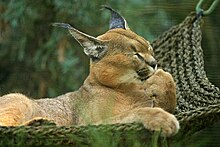
The Caracal
The caracal /ˈkærəkæl/ (Caracal caracal) is a medium-sized wild cat native to Africa, the Middle East, Central Asia, and India. It is characterised by a robust build, long legs, a short face, long tufted ears, and long canine teeth. Its coat is uniformly reddish tan or sandy, while the ventral parts are lighter with small reddish markings. It reaches 40–50 cm (16–20 in) at the shoulder and weighs 8–18 kg (18–40 lb). It was first scientifically described by German naturalist Johann Christian Daniel von Schreber in 1776. Three subspecies are recognised since 2017.
Typically nocturnal, the caracal is highly secretive and difficult to observe. It is territorial, and lives mainly alone or in pairs. The caracal is a carnivore that typically preys upon small mammals, birds, and rodents. It can leap higher than 3 m (9.8 ft) and catch birds in midair. It stalks its prey until it is within 5 m (16 ft) of it, after which it runs it down, the prey being killed by a bite to the throat or to the back of the neck. Breeding takes place throughout the year, with both sexes becoming sexually mature by the time they are a year old. Gestation lasts between two and three months, resulting in a litter of one to six kittens. Juveniles leave their mothers at nine to ten months, though a few females stay back with their mothers. The average lifespan of the caracal in captivity is nearly 16 years.
Caracals have been tamed and used for hunting since the time of ancient Egypt. The caracal was first described by German naturalist Johann Christian Daniel von Schreber as Felis caracal in 1776. In 1843, British zoologist John Edward Gray placed it in the genus Caracal. It is placed in the family Felidae and subfamily Felinae.
In the 19th and 20th centuries, several caracal specimens were described and proposed as subspecies. Since 2017, three subspecies are recognised as valid:
- Southern caracal (C. c. caracal) (Schreber, 1776) – occurs in Southern and East Africa
- Northern caracal (C. c. nubicus) (Fischer, 1829) – occurs in North and West Africa
- Asiatic caracal (C. c. schmitzi) (Matschie, 1912) – occurs in Asia
Results of phylogenetic studies indicated that the caracal evolved nearly a million years before the lynx. It is most closely related to the African golden cat (Caracal aurata). These two species together with the serval (Leptailurus serval) form the Caracal lineage, which evolved 8.5 million years ago (Mya). The ancestor of this lineage arrived in Africa 8.5–5.6 Mya. It diverged from the serval probably within the last five million years, between the Pliocene and the Pleistocene.
Etymology
The name "caracal" is composed of two Turkic words: kara, meaning black, and kulak, meaning ear. The first recorded use of this name dates back to 1760. Alternative names for the caracal include gazelle cat, red cat, rooikat, and red or Persian lynx. The "lynx" of the Greeks and Romans was most probably the caracal and the name "lynx" is sometimes still applied to it, but the present-day lynx proper is a separate species.
Credits: Wikipedia
Written by David Davidson

Wild life🌹
ReplyDeleteThanks
Delete